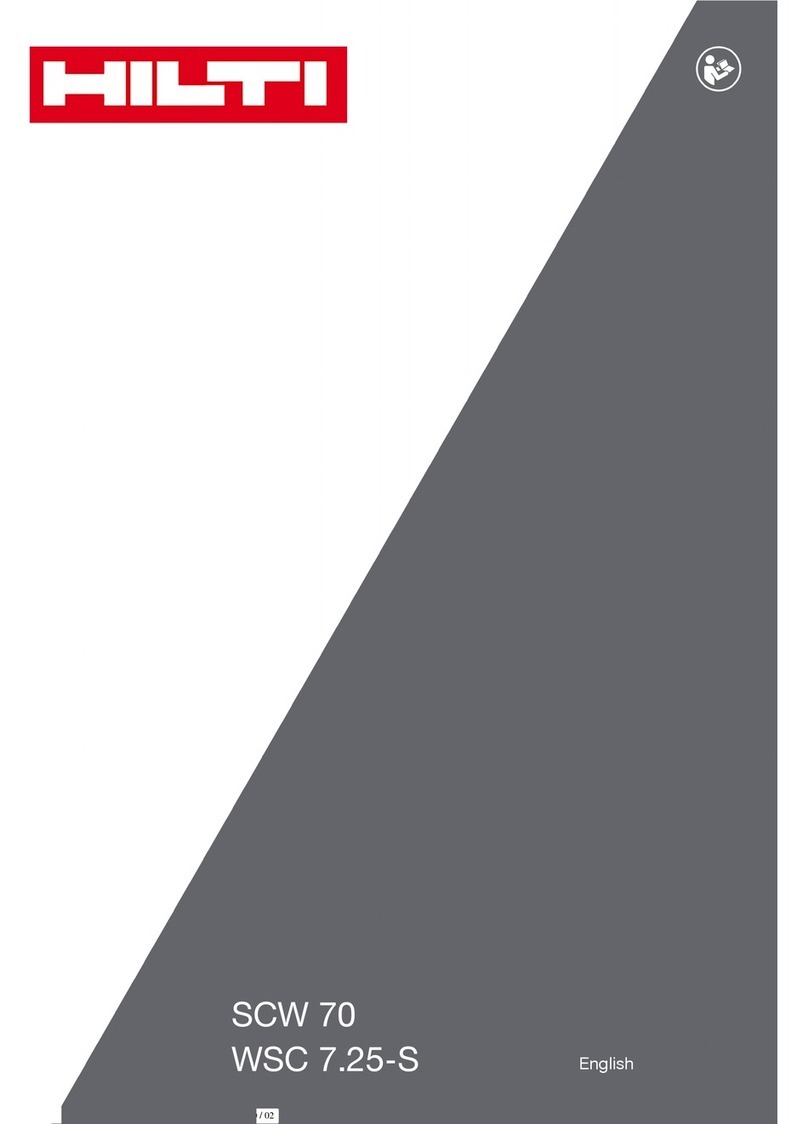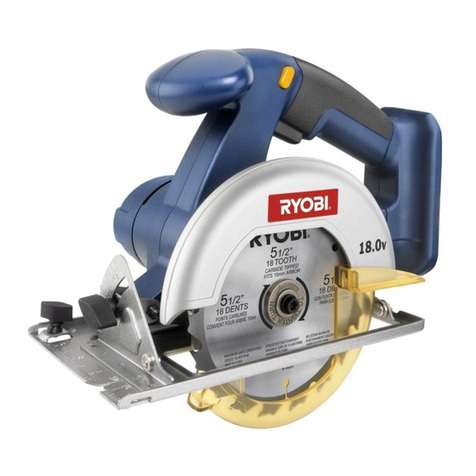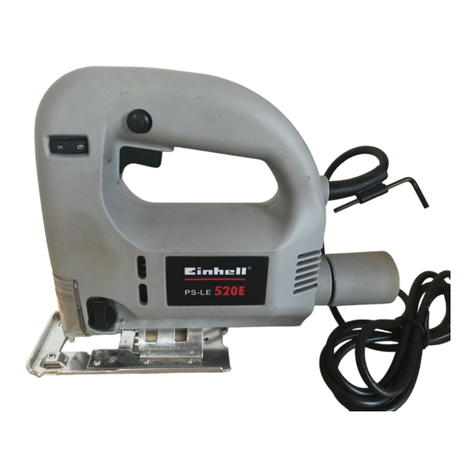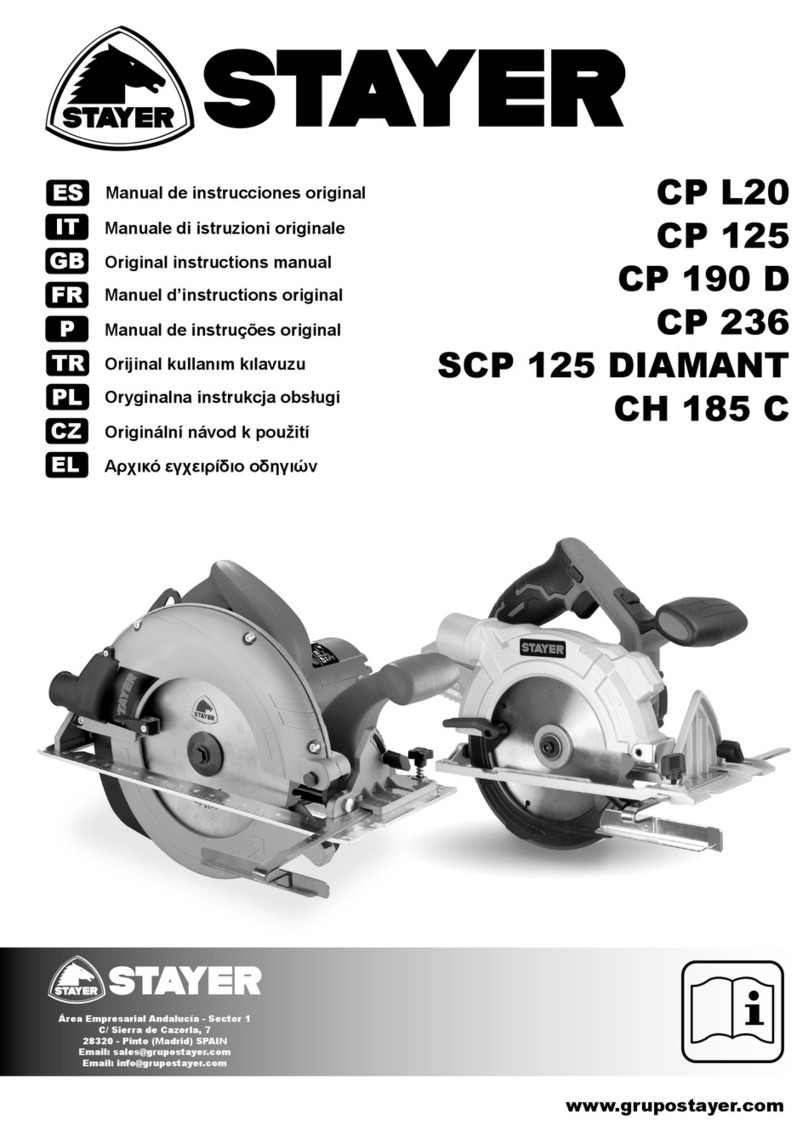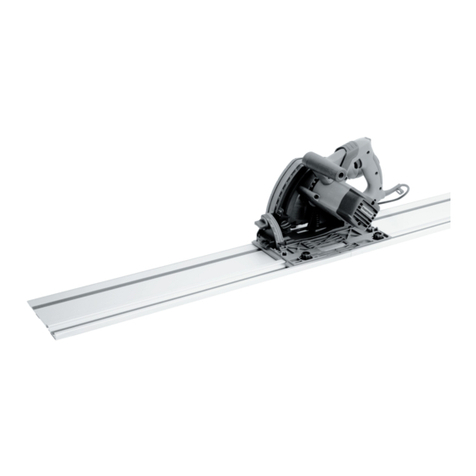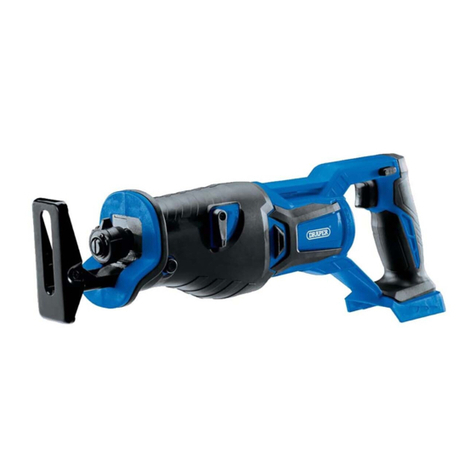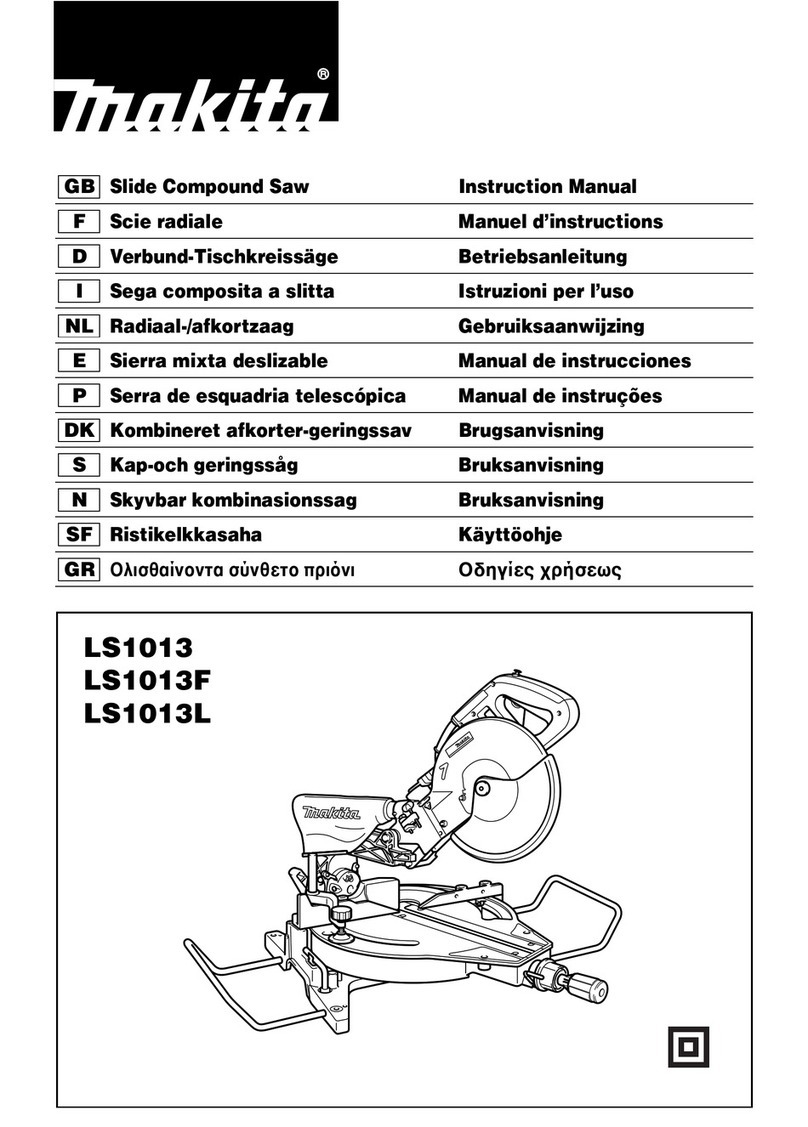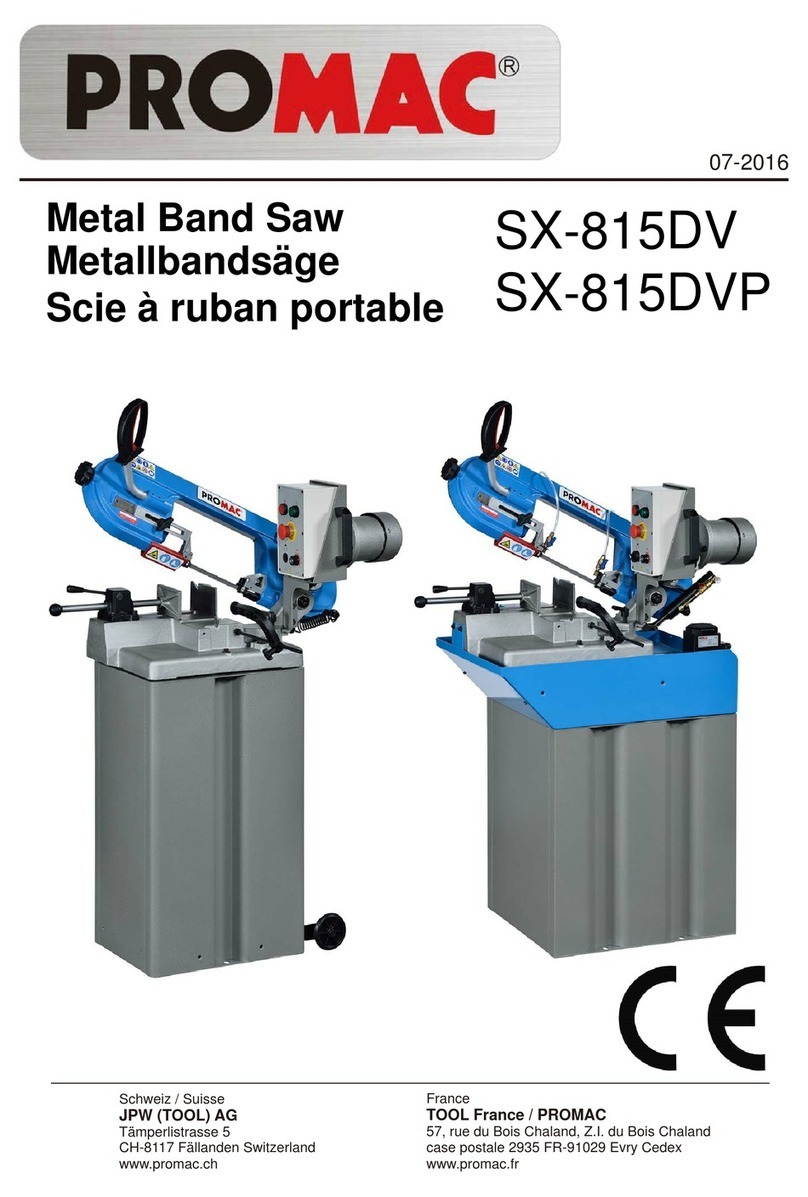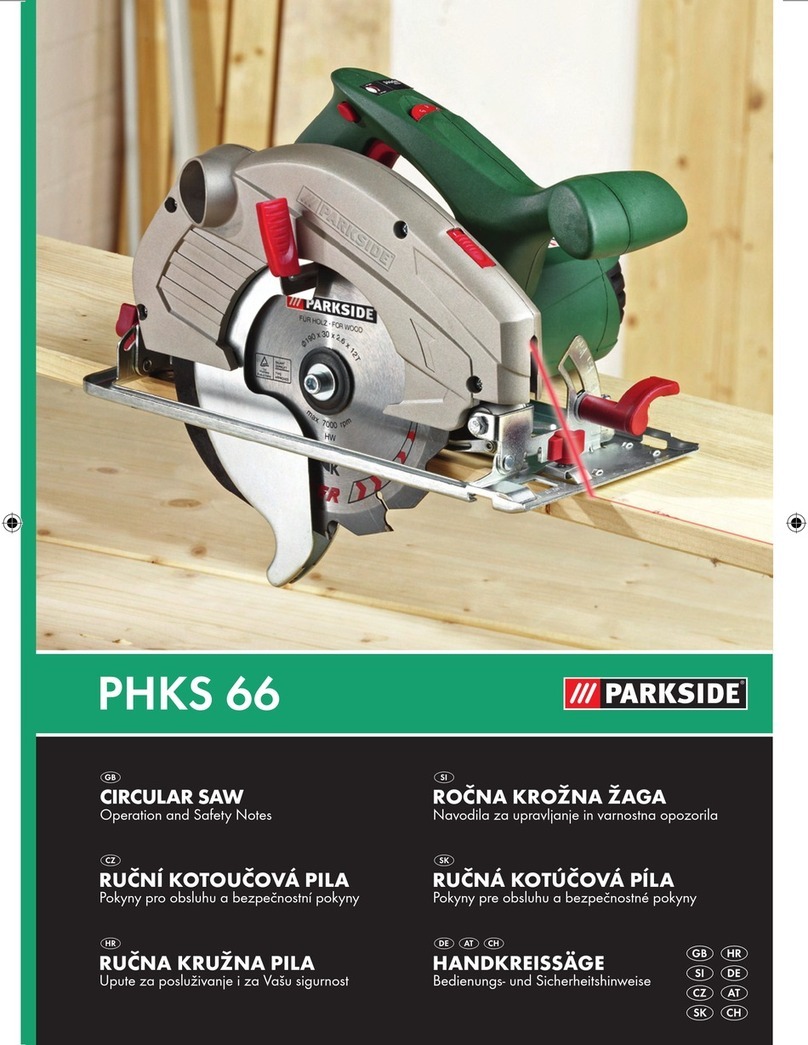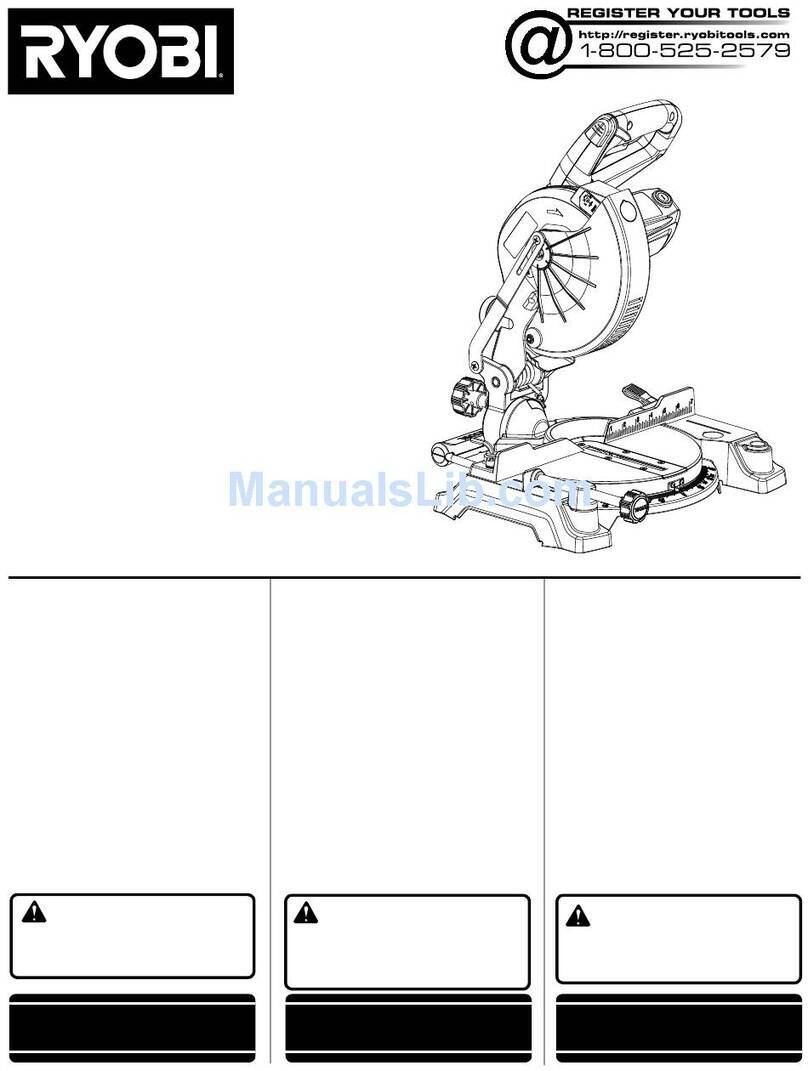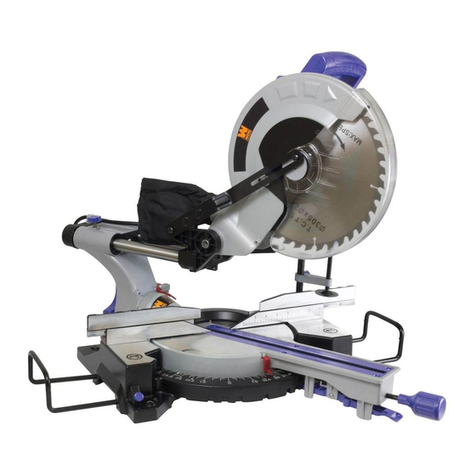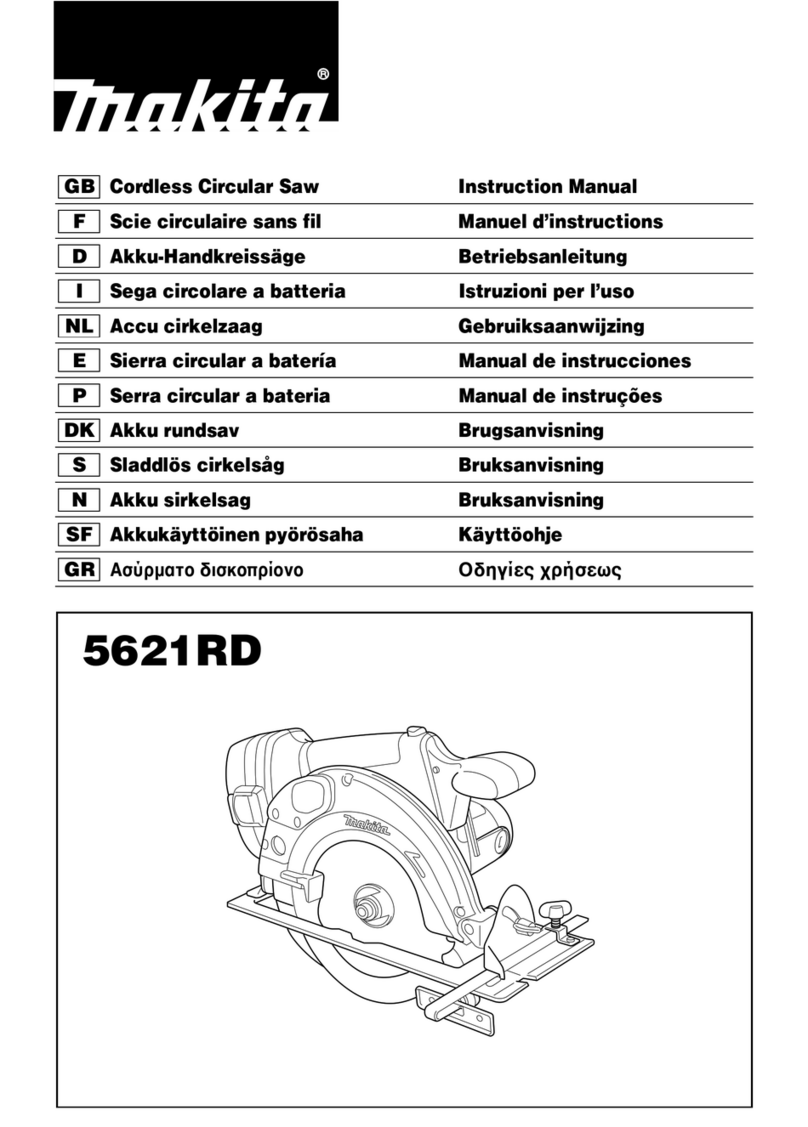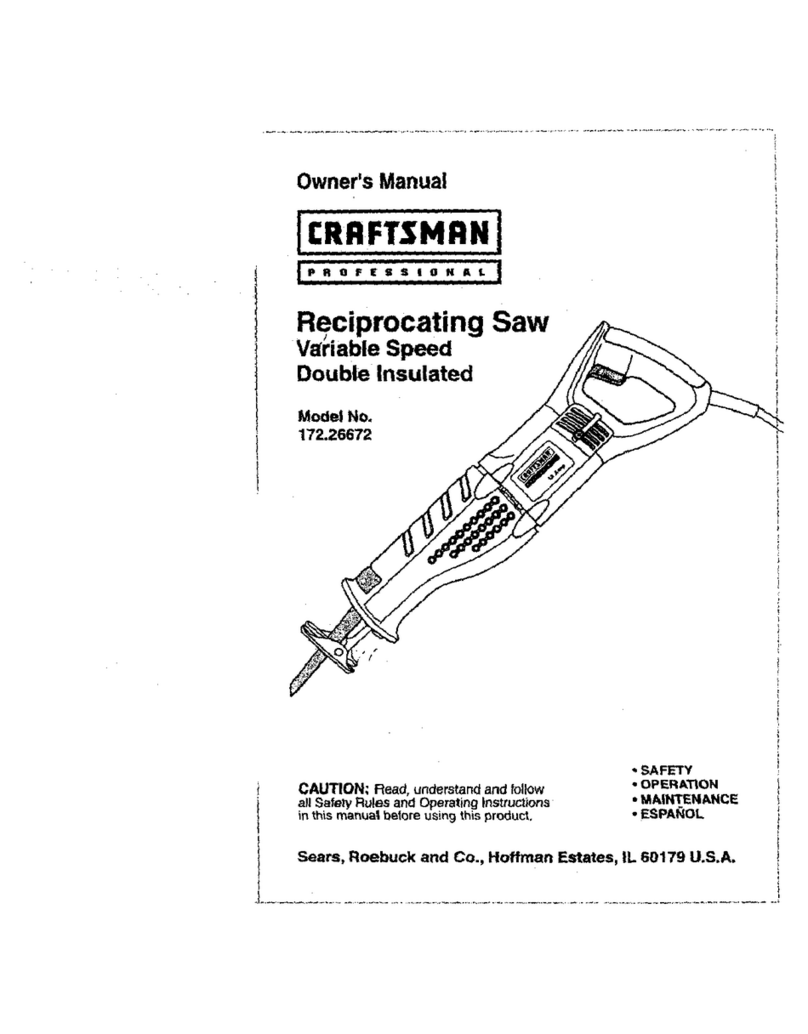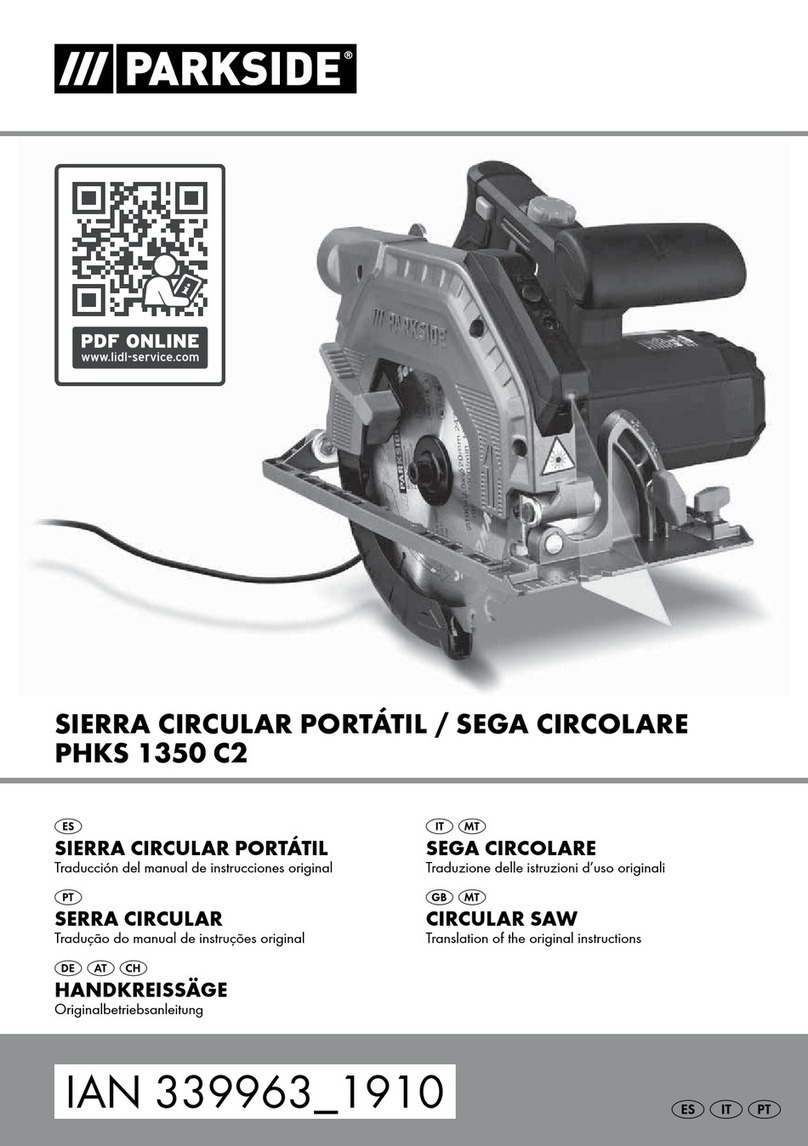Hilti WSR 1250-PE User manual

WSR900
WSR900-PE
WSR1250-PE
WSR1400-PE
*376750*
376750
Operating instructions en
Mode d’emploi fr
Manual de instrucciones es
Hilti Corporation
FL-9494 Schaan
Tel.:+423/2342111
Fax: +423/2342965
www.hilti.com
Hilti = registered trademark of Hilti Corp., Schaan W 2827 0704 5-Pos. 3 1 Printed in Liechtenstein © 2004
Right of technical and programme changes reserved S. E. & O.
376750/ C
V
V
V
V
V
13
15 16
14
12

WSR900-PE
min.40mm
1–6
2
3
WSR1250-PE
WSR1400-PE
V
V
V
V
V
2
4
5 6 7
min.40mm
3
min.40mm
min.25mm
WSR900-PE
B
A
WSR1250-PE
WSR1400-PE
WSR1400-PE
WSR1400-PE
WSR1400-PE
WSR1400-PE
WSR1400-PE
V
V
V
V
V
11
8 9
10
ULlisted to US and Canadien safety standards
HomologuéUL (conforme aux normes de sécurité américainesetcandiennes)
Productohomologado según normas de seguridad americanas ycanadienses
Produtohomologado de accordo com as normas desegurançaamericanasecanadianas
CUS
R
1
WSR1400-PE
1
12 11
2 3 4 5
9 810 7 6
V
V
V
V
V
6
WSR1250-PE
V
V
V
V
V
5
4
12 11 9 810 7
1 2
WSR900-PE
1
12 11
2 3 4 5
9 810
7
6
V
V
V
V
V
1
12 11
3 4 5
9 810
7
WSR 900
6
Thisproduct is UL listed and CSA certifiedtoUSandCanadien safety standards
Ceproduit est homologué UL et certifié CSA(conformeauxnormesde sécurité américaines et candiennes)
Productohomologado según normas de seguridad americanas ycanadienses
Produtohomologado de accordo com as normas desegurançaamericanasecanadianas
CUS C US
R
WSR900 / WSR 900-PE
WSR1250-PE / WSR1400-PE

1
en
It is essential that the operating instructions
are read before the tool is operated for the
first time.
Always keep these operating instructions
together with the tool.
Ensure that the operating instructions
are with the tool when it is given to other
persons.
1. General information
1.1 Signal words and their meaning
-WARNING-
ThewordWARNINGisusedtodrawattentiontoapoten-
tially dangerous situation which could lead to severe
personal injury or death.
-CAUTION-
Usedtodrawattentiontoapotentially dangerous situa-
tion which could lead to minor personal injury or dam-
ageto the equipmentor other property.
-NOTE-
Used to draw attention to an instruction or other useful
information.
1.2 Pictograms
Contents Page
1.General information 1
2.General safety rules 2
3.Specific safety rulesand symbols 3
4.Functional description 5
5.Assembly 6
6.Operation 7
7.Care and maintenance 8
8.Blades and accessories 8
9.Troubleshooting 9
10.Disposal 9
11.Warranty 10
Operating controls and parts
Blade clamp / blade holder
Orbital action selector switch
(onlyWSR900-PE/WSR1250-PE/WSR1400-PE)
Stroke rate regulator
(only WSR 900 / WSR 900-PE / WSR 1400-PE)
Transport lock
Control switch
Type plate
Motor
Gearing section
Front-end grip area (hand guard)
Lockbutton for adjusting the contact shoe
Contact shoe
Saw blade (insert tool)
These numbers refer to the corresponding illustra-
tions.The illustrations canbefoundon the fold-outcover
pages.Keepthese pages open while studyingthe oper-
atinginstructions.
Intheseoperating instructions, the WSR900/WSR900-
PE / WSR 1250-PE / WSR 1400-PE reciprocating saw
isreferred to as"the tool".
Location of identification data on the tool
Thetype designation andserialnumbercan be foundon
the rating plate on the tool. Make a note of this data in
your operating instructions and always refer to it when
makingan enquirytoyourHilti representativeorservice
department.
Type:
Serial no.:
Warning signs
General
warning Warning:
electricity Warning:
hot surface
Obligation signs
Wear
ear
protection
Wear
protective
gloves
Wear
breathing
protection
Wear
eye
protection
Read the
operating
instructions
before use.
Symbols
WSR900 / WSR900-PE / WSR1250-PE /
WSR1400-PE reciprocating saw

2
en
2. General safety rules
1. WARNING!
Read and understand all instructions.
Failuretofollowallinstructionslistedbelowmayresult
in electric shock, fire and/or serious personal injury.
SAVE THESE INSTRUCTIONS
2. Work Area
Keep your work area clean and well lit. Cluttered
benches and dark areas invite accidents.
Do not operate power tools in explosive atmos-
pheres, such as in the presence of flammable
liquids, gases, or dust. Power tools create sparks
which may ignite the dust or fumes.
Keep bystanders, children and visitors away while
operating a power tool. Distractions can cause you
to lose control.
3. Electrical Safety
Double Insulated tools are equipped with a polarized
plug (one blade is wider than the other.) This plug
will fit in a polarized outlet only one way. If the plug
does not fit fully in the outlet, reverse the plug. If it
still does not fit, contact a qualified electrician to
install a polarized outlet. Do not change the plug in
any way. Double Insulation Z eliminates the need for
the three wire grounded power cord and grounded power
supply system.Applicable only to Class II tools.
Avoid body contact with grounded surfaces such
as pipes, radiators, ranges and refrigerators.
There is an increased risk of electric shock if your
body is grounded.
Don’t expose power tools to rain or wet condi-
tions. Water entering a power tool will increase the
risk of electric shock.
Do not abuse the cord. Never use the cord to carry
the tools or pull the plug from an outlet. Keep cord
away from heat, oil, sharp edges or moving
parts. Replace damaged cords immediately.
Damaged cords increase the risk of electric shock.
When operating a power tool outside, use an out-
door extension cord marked «W-A» or «W». These
cords are rated for outdoor use and reduce the risk
of electric shock.
4. Personal Safety
Stay alert, watch what you are doing and use
common sense when operating a power tool. Do
not use a tool while tired or under the influence of
drugs, alcohol, or medication. A moment of inat-
tention while operating power tools may result in
serious personal injury.
Dress properly. Do not wear loose clothing or
jewelry. Contain long hair. Keep your hair, cloth-
ing, and gloves away from moving parts. Loose
clothes, jewelry, or long hair can be caught in mov-
ing parts.
Avoid accidental starting. Be sure switch is off
before plugging in. Carrying tools with your finger
on the switch or plugging in tools that have the
switch on invites accidents.
Remove adjusting keys or wrenches before
turning the tool on. A wrench or a key that is left
attached to a rotating part of the tool may result in
personal injury.
Do not overreach. Keep proper footing and bal-
ance at all times. Proper footing and balance
enables better control of the tool in unexpected situ-
ations.
Use safety equipment. Always wear eye protec-
tion. Dust mask, non-skid safety shoes, hard hat or
hearing protection must be used for appropriate
conditions.
5. Tool Use and Care
Use clamps or other practical way to secure and
support the workpiece to a stable platform. Hold-
ing the work by hand or against your body is unsta-
ble and may lead to loss of control.
Do not force tool. Use the correct tool for your
application. The correct tool will do the job better
and safer at the rate for which it is designed.
Do not use tool if the switch does not turn it on or
off. Any tool that cannot be controlled with the
switch is dangerous and must be repaired.
Disconnect the plug from the power source before
making any adjustments, changing accessories,
or storing the tool. Such preventive safety measur-
es reduce the risk of starting the tool accidentally.
Store idle tools out of reach of children and other
untrained persons. Tools are dangerous in the
hands of untrained users.
Maintain tools with care. Keep cutting tools sharp
and clean. Properly maintained tools with sharp
cutting edges are less likely to bind and are easier to
control.
Check for misalignment or binding of moving
parts, breakage of parts and any other condition
that may affect the tools operation. If damaged,
have the tool serviced before using. Many acci-
dents are caused by poorly maintained tools.
Use only accessories that are recommended by
the manufacturer for your model. Accessories that

3
en
3. Specific safety rules and symbols
3.1 Basic information concerning safety
In addition to the information relevant to safety given
in each of the sections of these operating instructions,
thefollowingpointsmustbestrictlyobserved at all times.
-WARNING-
Read all safety precautions and instructions! Failure to
observe the following safety precautions and instruc-
tionsmayleadtoelectricshock,fireand/orseriousinjury.
3.2 Take the necessary precautions to make the
workplace safe
●Ensurethat the workplaceis well ventilated.
●Keeptheworkingareatidy.Objectswhich could cause
injury shouldberemovedfromthe workingarea.Untidi-
ness at the workplace may lead to accidents.
●Keepthe area aboveandbelowthe cutting linefreeof
obstacles.
●Wear suitable working clothing. Wearahairnetifyou
havelong hair.
●Donotpermitotherpersonstotouchtheelectrictool
or the extension cord.
●Avoid unusual body positions. Work from a secure
stance and stay in balance at all times.
●To avoidtripping and fallingwhenworking,always lead
thesupply cord andextension cord awayto the rear.
●Concealedelectric cables orgasandwater pipes pre-
senta serious hazardifdamagedwhile you arework-
ing.Accordingly, check theareainwhich you arework-
ingbeforehand (e.g. usinga metal detector).
●Unknownbasematerialsshouldbeexaminedinorder
to avoid personal injury or the possibility of cutting
intopipesorcables.Usetherightbladeforthemate-
rial being cut.
●Do not cut unless there is proper clearance beyond
theworkpiecebeingcut.Theblademaycausethetool
to kick-back if it strikes a hidden object.
●Beforecutting pipes, alwaysfirstensurethat the pipes
contain no liquids. Empty the pipes if necessary. The
tool is not water or moisture proof. Liquids running
outmay cause ashortcircuitinthe tool resultinginan
electricshock being received.Whencuttingpipes, hold
thetool so thatit is higherthan the pipebeing cut.
3.3 General safety precautions
●To ensure efficient and safe operation, the contact
shoe of the tool must be pressed against the work-
piece .
●Keep the tool, especially its grip surfaces, clean and
freefrom oil andgrease.
●Alwayshold the toolsecurely,withboth hands onthe
gripsprovided .Make sure to grip the tool and posi-
tion your hands and fingers so they will not contact
or slip into the area of the blade clamp or saw blade.
●Switchonthe tool only after it hasbeenbrought into
position where the cut is to be made.
●Donotstartthetoolwiththebladecontactingthework
surface.
●When cutting, always guide the tool away from the
body.
●Switch the tool off before transporting it.
●Alwaysallowthetooltocometoacompletestopbefore
removing it from the workpiece.
●Neverplaceyourhandsinfrontoforonthesawblade.
●Checkthetoolforpossibledamage.Protectivedevices
and any parts that may have suffered slight damage
should be checked for correct operation and func-
tionalitybeforefurtheruse of the electric tool. Safety
devices or other parts that are found to be damaged
must be replaced or repaired properly by an autho-
rized repair workshop unless otherwise indicated in
the operating instructions.
●Always use saw blades of adequate length. To help
avoidkick-backwhilesawing,theblademustalways
projectatleast40mm(1.5in)beyondtheworkpiece
during the stroke cycle .
3.3.1 Mechanical
●Ensurethat the sawbladesusedare equipped withthe
correctconnection end systemandthatthey are prop-
erlyfitted and securedin the bladeclamp.
may be suitable for one tool may become hazardous
when used on another tool.
6. Service
Tool service must be performed only by qualified
repair personnel. Service or maintenance per-
formed by unqualified personnel could result in a risk
of injury.
When servicing a tool, use only identical replace-
ment parts. Follow instructions in the Maintenance
section of this manual. Use of unauthorized parts or
failure to follow Maintenance Instructions may create
a risk of electric shock or injury.

4
en
3.3.2 Electrical
●Protect yourself against electric shock. Avoid body
contact with earthed / grounded objects, e.g. pipes
and radiators etc.
●Check the condition of the tool’s supply cord at reg-
ularintervals. The supply cord should be replaced by
atrainedelectricalspecialistifdamageisfound.Also
regularlycheck the condition ofextension cords and
replace these if damage is found.
●Donot touch the supply cord in the event of it suffer-
ingdamage while working.Disconnectthesupply cord
plugfrom the powersupply.
●The tool should be repaired only by a trained electri-
calspecialist (Hilti service centre) using originalHilti
spareparts.Failuretoobserve this point my result in
a risk of accident to the user.
●Do not use the supply cord for purposes for which it
is not intended.
●Never carry the tool by the power supply cord.
●Do not pull the plug out of the socket by pulling the
supply cord.
●Do not expose the supply cord to heat, oil or sharp
edges.
●When working outdoors, use only extension cords
approvedand correspondingly markedassuitablefor
outdooruse.
●Avoid using extension cords with multiple sockets
andthesimultaneoususeofseveralelectrictoolscon-
nected to one extension cord.
●Never operate the tool when it is dirty or wet. Dust or
dampness on the surface of the tool make it difficult
to hold and, under unfavorable conditions, may lead
toelectric shocks. Accordingly, have the tool checked
regularlyataHiltiservice center if it is used frequently
for cutting conductive materials.
●Hold tool by insulated gripping surfaces when per-
formingan operation where the cuttingtool may con-
tact hidden wiring or its own cord. Contact with a
“live” wire will make exposed metal parts of the tool
“live”and shock theoperator.
3.3.3 Thermal
●Thesaw blade maybecomehotduring use. Youshould
therefore wear protective gloves when changing saw
blades.
●When using the pipe cutting adaptor (accessory),
especially when cutting large-diameter pipes, apply
only moderate pressure and select a suitable cutting
speed in order to avoid overheating the tool.
●Thecutting produced when sawing, especially metal
cuttings,maybehot.Wearsuitableprotectiveclothing.
3.3.4 Dust
●Wear respiratory protection when the work causes
dust.
●Before beginning work, find out the hazard class of
thedustproducedbythework.Useonlyanindustri-
alvacuumcleanerwithanofficiallyapprovedprotec-
tionclassification in compliance with yourlocal dust
control regulations for work with the tool.
●Proposition65warning:Thisproductcontainsorpro-
duces an exposure to chemicals known to the State
ofCaliforniatocausecancerandbirthdefects(orother
reproductive harm).
3.4 Requirements to be met by users
●Thetool is intendedfor professional use.
●Thetoolmaybeoperated,serviced and repaired only
byauthorized, trained personnel.Thispersonnelmust
beinformed of anyspecialhazardsthat may beencoun-
tered.
●Take breaks between working and do exercises your
fingers to relax the muscles and improve the blood
circulation in your fingers.
3.5 Personal protective equipment
Theuser and anyotherpersonsin the vicinitymustwear
suitable eye protection. Ear protection and protective
glovesshould be wornasconditionswarrant. They must
also wear breathing protection if no dust removal sys-
temis used.
3.6 Protective devices
Never use the tool without the hand guard fitted.
Symbols used on the tool:
Vvolts n0no load speed
~alternating current /min revolutionsperminute
Hz hertz ∅diameter
Aamperes Zdouble insulated
Wear
ear
protection
Wear
protective
gloves
Wear
breathing
protection
Wear
eye
protection

5
en
4. Functional description
4.1 Use of the WSR 900 / WSR 900-PE as directed
●Typicalworkingenvironmentsincluderescueservices,
publicauthorities,farmingandforestry, general con-
struction,renovationandconversionwork,metalcon-
struction,plumbing/heating/air-conditioning instal-
lationtrades,inworkshopsandonconstructionsites.
●The tool may be used for cutting wood, wood-like
materials, metals and plastics.
●The tool must be used in a dry environment.
●The tool may be powered only by an electric supply
voltage in compliance with the information given on
the type plate.
●The tool is designed for two-handed operation.
●Useonlythebladesandaccessorieslistedintheoper-
ating instructions.
●Do not use the tool to cut bricks, concrete, cellular
concrete, natural stone or tiles.
●Use the tool within its intended cutting performance
range and with suitable blades (do not use blades of
thewrongsizeorreciprocatingsawbladesnotequipped
with a 1/2" connection end).
●Cuttingmaterialscontainingasbestosisnotpermissible.
4.2 Use of the WSR 1250-PE / WSR 1400-PE as
directed
●Typical working environments include general con-
struction,renovationandconversionwork,metalcon-
struction,plumbing/heating/air-conditioning instal-
lationtrades,rescueservices, public authorities, farm-
ing and forestry, in workshops and on construction
sites.
●The tool may be used for cutting wood, wood-like
materials, metals, plastics, bricks, cellular concrete
and tiles.
●The tool must be used in a dry environment.
●The tool may be powered only by an electric supply
voltage in compliance with the information given on
the type plate.
●The tool is designed for two-handed operation.
●Useonlythebladesandaccessorieslistedintheoper-
ating instructions.
●Do not use the tool to cut concrete or natural stone.
●Use the tool within its intended cutting performance
range and with suitable blades (do not use blades of
thewrongsizeorreciprocatingsawbladesnotequipped
with a 1/2" connection end).
●Cuttingmaterials containing asbestos is not permis-
sible.
4.3 The items supplied include:
– Reciprocating saw and saw blade
– Operating instructions
– Toolbox
Seefigureandtheexplanationsofoperatingcontrols
and components on page 1.
Technical data
Tool WSR 900 WSR 900-PE WSR 1250-PE WSR 1400-PE
Nominal power
rating 900 W 900 W 1250 W 1400 W
Nominal
voltage 120 V / 8.5 A 120 V / 8.5 A 120 V / 12 A 120 V / 13 A
Nominal
current input
Mains
frequency 50 / 60 Hz 50 / 60 Hz 50 / 60 Hz 50 / 60 Hz
Weight of tool 6.28 lbs (2.85 kg) 7.2 lbs (3.26 kg) 9.3 lbs (4.2 kg) 9.9 lbs (4.5 kg)
Dimensions 17.4×3.5×8.3 in 17.4×3.5×8.3 in 19.4×4×7.1 in 22.6×4×7.4 in
(L×B×H) (442×88×211 mm) (442×88×211 mm) (493×101×180 mm) (574×101×188 mm)
Stroke rate 0–2700 min–1 0–2700 min–1 0–2700 min–1 0–2700 min–1
Stroke 11/4in (32 mm) 11/4in (32 mm) 11/4in (32 mm) 11/4in (32 mm)

6
en
5. Assembly
-NOTE-
Theelectricsupplyvoltagemustcomplywiththeinfor-
mation on the type plate.
If extension cords are used: Use only extension cords
ofatypeapprovedfortheintendedpurposeandofade-
quate cross section. Failure to observe this point may
resultinreducedperformance and may cause the cord
tooverheat.Replacedamagedextensioncords.Useonly
correspondinglymarkedandapprovedextensioncords
for working outdoors. Recommended minimum cross
sections and max. cord lengths:
Mains Conductor cross section AWG
voltage 1.5 mm22.5 mm214 12
110–120V 20m 40m 75ft 125ft
230V 50m 100 m – –
5.1 Fitting the saw blade
1. Unplug the supply cord from the electric socket.
2. Check that the connection end of the blade is clean.
Thebladeclamp should also be kept clean.Useonly
saw blades with 1/2″connection ends .
3.Turn the blade clamp locking sleeve in a counter-
clockwise direction and hold it in this position.
4. Push the saw blade into the blade clamp.
5.Releasethelockingsleeveandallowittomoveback.
It should be heard to engage.
6. Check that the clamp has engaged by pulling on the
blade.
5.2 Removing the saw blade
1. Unplug the supply cord from the electric socket.
2.Turn the blade clamp locking sleeve in a counter-
clockwise direction and hold it in this position.
-CAUTION-
●The cutting edges of the saw blade
are sharp.
●Thecuttingedgesmaypresentarisk
of injury.
●Moving parts may present a risk of
injury.
●Wear protective gloves.
3.Pullthebladeoutoftheclamptowardthefrontofthetool.
4. Release the locking sleeve.
5.3 Adjusting the contact shoe
The contact shoe can be adjusted to provide optimum
useofthebladelengthandtoimproveaccessincorners.
1. Unplug the supply cord from the electric socket.
2. Remove the saw blade (see 5.2).
3. Press the contact shoe lockbutton and hold it in this
position.
4.Slidethecontactshoeforwardorbackintothedesired
position.
5. Release the lockbutton.
6.Pullonthecontactshoetocheckthatithasengaged.
5.4 Using the pipe cutting adaptor
(accessory)
1. Unplug the supply cord from the electric socket.
2. Remove the saw blade (see 5.2).
3. Press the contact shoe lockbutton and hold it in this
position.
4. Pull the contact shoe away from the tool toward the
front.
5. Push the pipe cutting adaptor into the tool from the
front until it is in the desired position.
6. Release the lockbutton.
7.Pull on the pipe cutting adaptor to check that it has
engaged.
8. Open the screw clamp to the maximum position.
9. Place the adapter chain around the pipe, locking the
chain to the fitting.
-NOTE- The handle should be at a 45° angle.
5.5 Fitting the side handle (accessory)
1. Unplug the supply cord from the electric socket.
2. Remove the saw blade (see 5.2).
3.Place the adaptor around the front grip section from
above and close the adaptor.
4.Slidethesidehandleontotheadaptorfromthefront.
5.Securethesidehandlebyturningthescrew knob on
the handle.
5.6 Positioning the side handle (accessory)
1. Unplug the supply cord from the electric socket.
2. Slacken the screw knob on the side handle.
3. Bring the side handle into the desired position.
4.Securethesidehandlebyturningthescrew knob on
the handle.
Stroke rate Constant-speed elec- Constant-speed elec- Constant-speed elec- Constant-speed elec-
regulation tronics with variable tronics with variable tronics with variable tronics with variable
stroke rate, stroke rate stroke rate, stroke rate stroke rate strokerate, stroke rate
regulator with 6 pos. regulator with 6 pos. regulator with 6 pos.
Blade clamp Keyless, for standard 1/2″blades
Orbital action on / off (only WSR900-PE / WSR1250-PE / WSR1400-PE)
Double insulated Protection class II (double insulated) Z
Rightoftechnicalchangesreserved

7
en
6. Operation
-NOTE-
●To ensuregoodcuttingperformance and ease the load
onthetool,useonlysawbladesthatareingoodcon-
dition.
●Do not overload the tool.
-WARNING-
●When working, always guide the tool away from the
body.
●Lift the tool away from the workpiece only once the
blade has come to a standstill.
●Do not lay the tool down before the blade has come
to a standstill.
-CAUTION-
●The cutting edges of the saw blade
are sharp.
●Thecuttingedgesmaypresentarisk
of injury.
●Wear protective gloves.
-WARNING-
●Thesawingoperationswirlsupdust
and wood chips into the air.
●Thedust and woodchipsmaybe harm-
fulto the eyesandrespiratory system.
●Wear protective goggles and breath-
ing protection.
-WARNING-
●Operation of the tool creates noise.
●Excessivenoisemaydamagethehear-
ing.
●Wear ear protection.
-CAUTION-
●The saw blade becomes hot when
used for long periods.
●Thereisariskofburningiftheblade
is touched.
●Wear protective gloves.
6.1 Switching on/off
1. Plug the supply cord into the electric socket.
2.Press the transport lock and then press the control
switch.
6.2 Stroke rate
6.2.1 Adjusting the stroke rate
The recommended stroke rate can be selected by turn-
ingthe stroke rateregulator. Whenthecontrolswitch is
pressedthe tool willthenrunup to thepre-selectedspeed.
Theelectronic speed controlsystemmaintainsconstant
stroke rate even under load. The recommended stroke
rate settings and information concerning the correct
choice of saw blade can be found in the product infor-
mationand in thecorresponding table ofapplications.
6.2.2 Recommended stroke rates
(1 = low stroke rate, 6 = high stroke rate)
Material to be cut Recommended
stroke rate
Wood 5–6
Wood with embedded nails 5–6
Interior finishing, drywall 3–4
Plastic 3–4
Steel 2–3
Non-ferrous metals 2–3
Aluminum 2–3
Stainless steel 1
The above settings are general guidelines intended to
provideoptimumcuttingperformance. These also apply
whenthepipecuttingadapter(accessory) is used. The
optimum setting may differ from these recommenda-
tionsdependingonthesawbladeused,theelectricsup-
plyvoltageandonhowthetoolisused.Settingthewrong
strokeratemaycausethesawbladetowearmorequickly,
and could damage the tool.
6.3 Orbital action (only WSR900-PE /
WSR 1250-PE / WSR 1400-PE)
Use of the orbital action can increase cutting perfor-
manceincertainsoftmaterialssuchaswoodmaterials.
The orbital action can be switched on or off by moving
the orbital action selector switch as far as it will go in
eachposition.Movetheswitchonlywhenthemotorhas
stopped.
6.3.1 Orbital action off
Orbital action off
6.3.2 Orbital action on
Orbital action on

8
en
7. Care and maintenance
Unplugthe supply cordfrom the mainssocket.
7.1 Care of blades
Cleanoff dirt anddustdepositsand protect yourblades
from corrosion by wiping them from time to time with
anoil-soaked rag.
7.2 Care of the tool
●Keep the blade clamp clean.
●Thetoolwaslubricatedadequatelywhenitwasman-
ufactured. After long periods of heavy use it is rec-
ommended that the tool is inspected at a Hilti repair
center. This will increase the life expectancy of the tool
and avoid unnecessary repair costs.
●Repairstotheelectricalsectionofthetoolmaybecar-
ried out only by a trained electrical specialist.
Theoutercasing of the toolis made from impact-resis-
tantplastic.Sectionsofthegrip are made from an elas-
tomermaterial.
Never operate the tool when the ventilation slots are
blocked. Clean the ventilation slots carefully using a dry
brush.Donotpermit foreignobjectstoenterthe interior
ofthetool.Clean theoutsideofthetool atregularintervals
using a slightly damp cloth. Do not use a spray, steam
pressurecleaningequipmentor runningwaterforcleaning.
Thismaynegativelyaffect theelectricalsafetyofthe tool.
Alwayskeepthegrip surfacesofthetoolfreefromoiland
grease.Donotuse cleaningagentswhichcontainsilicone.
7.3 Maintenance
Checkall external partsofthetool for damageatregular
intervals and check that all controls operate faultlessly.
Donot operate thetoolifparts are damagedorwhenthe
controls do not function faultlessly. If necessary, your
electrictool should berepaired at aHilti repair center.
Repairs to the electrical section of the tool may be car-
riedout only bytrained electrical specialists.
7.4 Checks after care and maintenance
After care and maintenance, check that the hand guard
and contact shoe are fitted and that they function fault-
lessly.
6.4 Plunge sawing
The plunge sawing technique should be used only on
soft materials and when the orbital action is switched
off. A little practice is required in order to be able to
plunge the blade into the material while the tool is run-
ningandthusmakecut-outswithoutfirstdrillingahole.
Plunge sawing is possible only with short saw blades.
Plunge cuts may be started with the tool in one of two
different positions:
– in the normal position
– or in the reversed position
1. Hold the tool with the front edge of the contact shoe
against the workpiece.
2.Press the transport lock and then press the control
switch.
3.Pressthetoolfirmlyagainsttheworkpieceandbegin
the plunge movement by reducing the angle of the
tool (contact shoe) to the workpiece. It is important
to ensure that the tool is running before the blade is
broughtintocontactwiththeworkpiece.Thetoolmay
otherwise stall or kick-back.
4.Once the blade has passed through the workpiece,
bring the tool into the normal working position (the
entire surface of the shoe in contact) and then con-
tinue sawing along the line.
8. Blades and accessories
Saw blades
Pipe cutting adaptor
Side handle / Side handle adaptor

9
en
10. Disposal
Most of the materials from which Hilti electric tools are manufactured can be recycled. The materials must be
correctlyseparated before theycanberecycled. In manycountries,Hiltihas already madearrangementsfortaking
back your old electric tools for recycling. Please ask your Hilti customer service department or Hilti representa-
tivefor further information.
Should you wish to return the electric tool yourself to a disposal facility for recycling, proceed as follows:
Dismantle the electric tool as far as possible without the need for special tools. Use absorbent paper to wipe oily
partsclean and tocollectanygrease that runsout(totalquantity approx. 50ml).Thispaper should alsobedisposed
of correctly. On no account should oil or grease be allowed to enter the waste water system or to find its way
into the ground.
The individual parts should be separated as follows:
Part / assembly Main material Recycling
Toolbox Plastic Plasticsrecycling
Gearhousing Aluminium Scrapmetal
Grip Plastic Plasticsrecycling
Motorhousing Plastic Plasticsrecycling
Gripcover Plastic Plasticsrecycling
Fan Plastic Plasticsrecycling
Motor(rotor and stator) Steeland copper Scrapmetal
Supplycord Copper, elastomer Scrap metal
Gearingparts Steel Scrapmetal
Screws,small parts Steel Scrap metal
Fault Possible cause Remedy
Thetool doesn't start. Faultin mains supply. Plug in another electric appliance and
checkwhether it works.
Supplycord or plugdefective. The cord should be checked and, if neces-
sary, replaced by an electrical specialist.
Controlswitch defective. The switchshouldbecheckedand, ifneces-
sary, replaced by an electrical specialist.
Thetool does notachieve Extensioncord with inadequatecross Use an extension cord with adequate cross
fullpower. section used. section.(See "Assembly".)
Lowstroke rate selected. Setthe stroke rateregulator to thesetting
recommendedfor the materialto be cut
(seesection "Assembly").
Controlswitch not pressedfully. Press the controlswitch as faras it will
go.
Noorbital action Orbitalaction selector switchnot Set the orbitalaction selector switchto
(onlyWSR900-PE / set to[]. []
.The orbital actioncan be feltonly
WSR1250 PE / whensawing.
WSR1400-PE).
Sawblade cannot be Lockingsleeve not turnedas far as Turn the locking sleeve as far as it will go
removedfrom the blade itwill go. andremove the sawblade.
clamp.
Contactshoe or pipe Obstructedby blade. Removethe saw blade(see 5.2) andthen
clampcannot be removed removethe contact shoe.
fromethe tool. Lockbutton is not fully pressed. Press the lockbutton fully and remove the
blade.
9. Troubleshooting

10
en
11. Warranty
Hilti warrants that the tool supplied is free of defects
in material and workmanship. This warranty is valid
so long as the tool is operated and handled correctly,
cleaned and serviced properly and in accordance with
the Hilti Operating Instructions, all warranty claims
are made within 12 months from the date of the sale
(invoice date), and the technical system is main-
tained. This means that only original Hilti consum-
ables, components and spare parts may be used in
the tool. This warranty provides the free-of-charge
repair or replacement of defective parts only. Parts
requiring repair or replacement as a result of normal
wear and tear are not covered by this warranty.
Under no circumstances will Hilti be obligated for
direct, indirect, incidental or consequential dam-
ages, losses or expenses in connection with, or by
reason of, the use of, or inability to use the tool for
any purpose. Hilti specifically excludes the implied
warranties of merchantability and fitness for a par-
ticular purpose.
For repair or replacement, send tool and/or related
parts immediately upon discovery of the defect to the
address of the local Hilti marketing organization pro-
vided.
This constitutes Hilti’s entire obligation with regard to
warranty and supersedes all prior or contempo-
raneous comments and oral or written agreements
concerning warranties.
This manual suits for next models
3
Table of contents
Other Hilti Saw manuals

Hilti
Hilti WSC 85 User manual

Hilti
Hilti SR 30 User manual
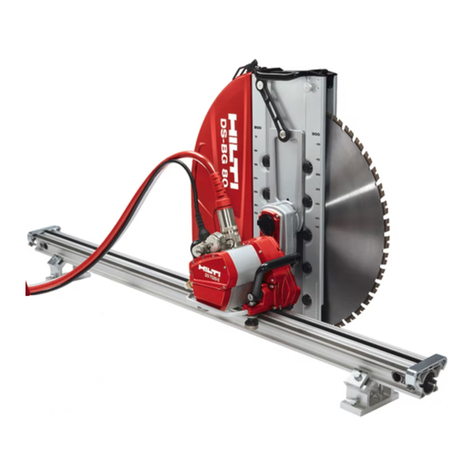
Hilti
Hilti DS TS20-E User manual
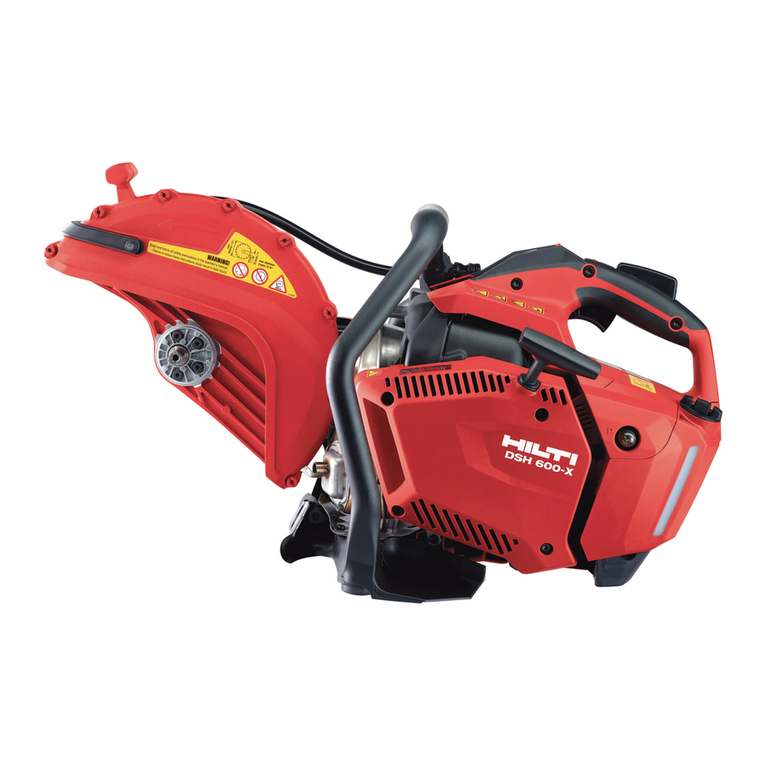
Hilti
Hilti DSH 600-X User manual
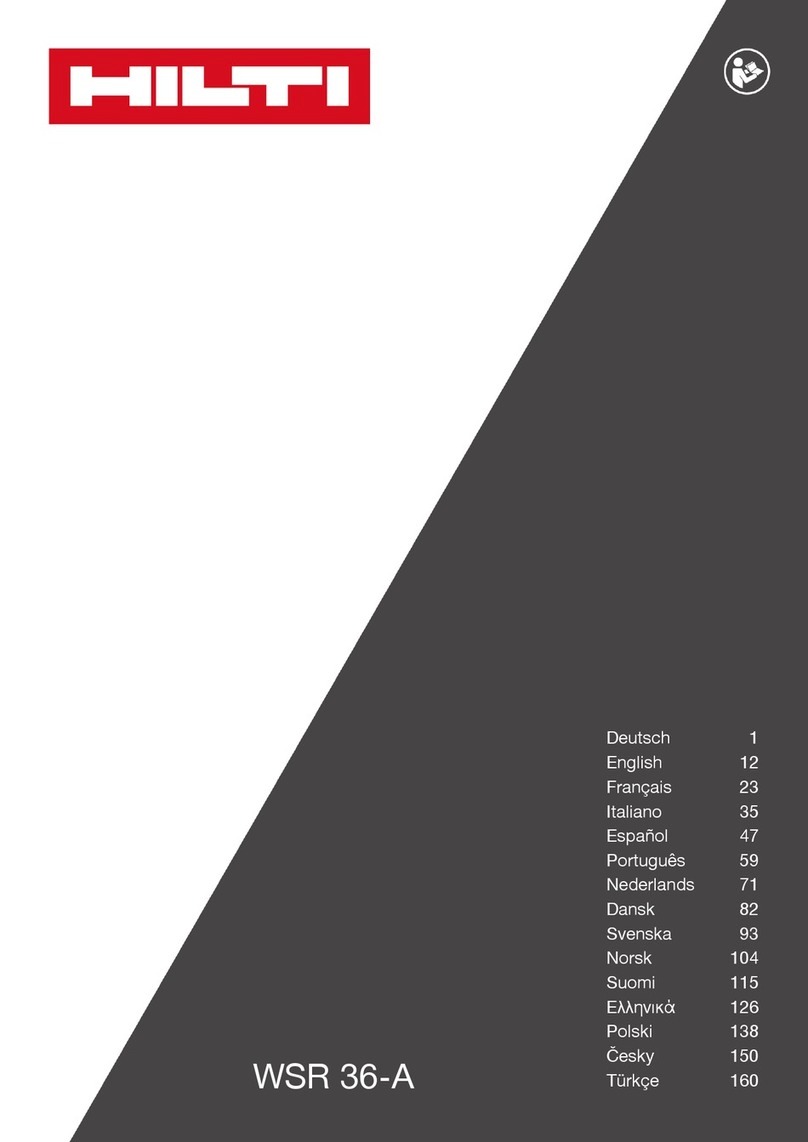
Hilti
Hilti WSR 36-A User manual

Hilti
Hilti SR 2-A12 User manual

Hilti
Hilti WSR 900-PE User manual
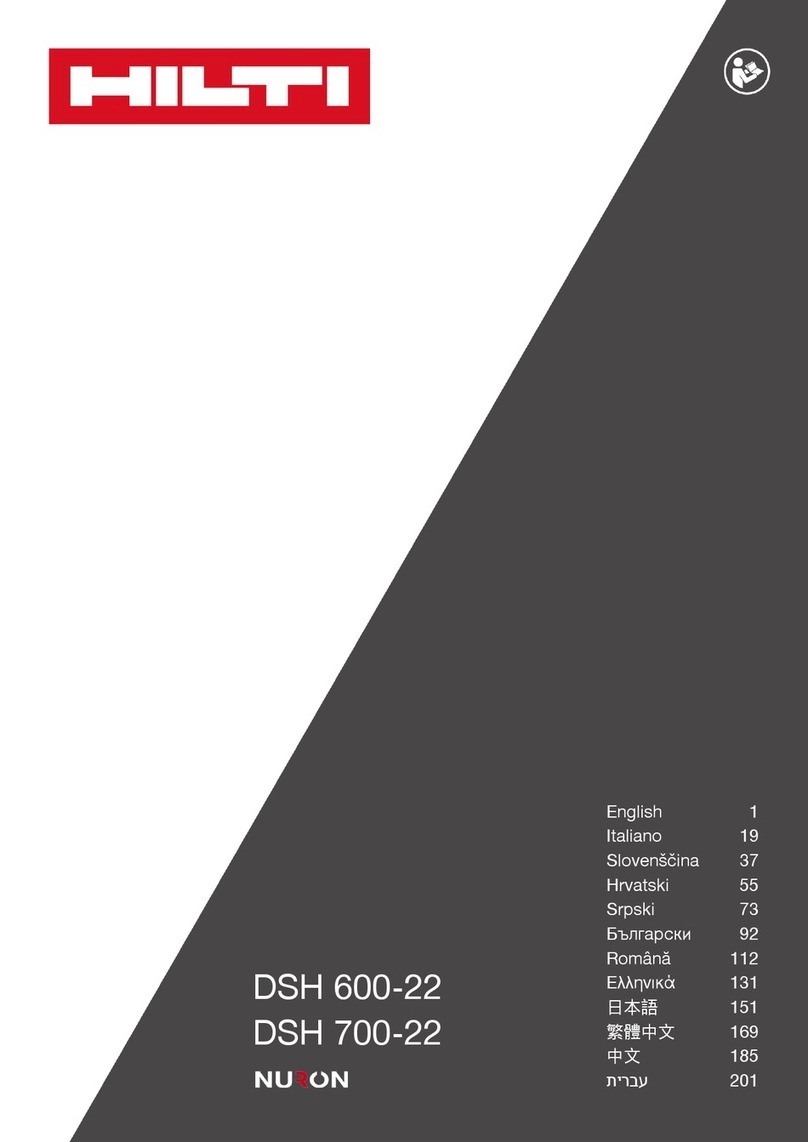
Hilti
Hilti Nuron DSH 600-22 User manual
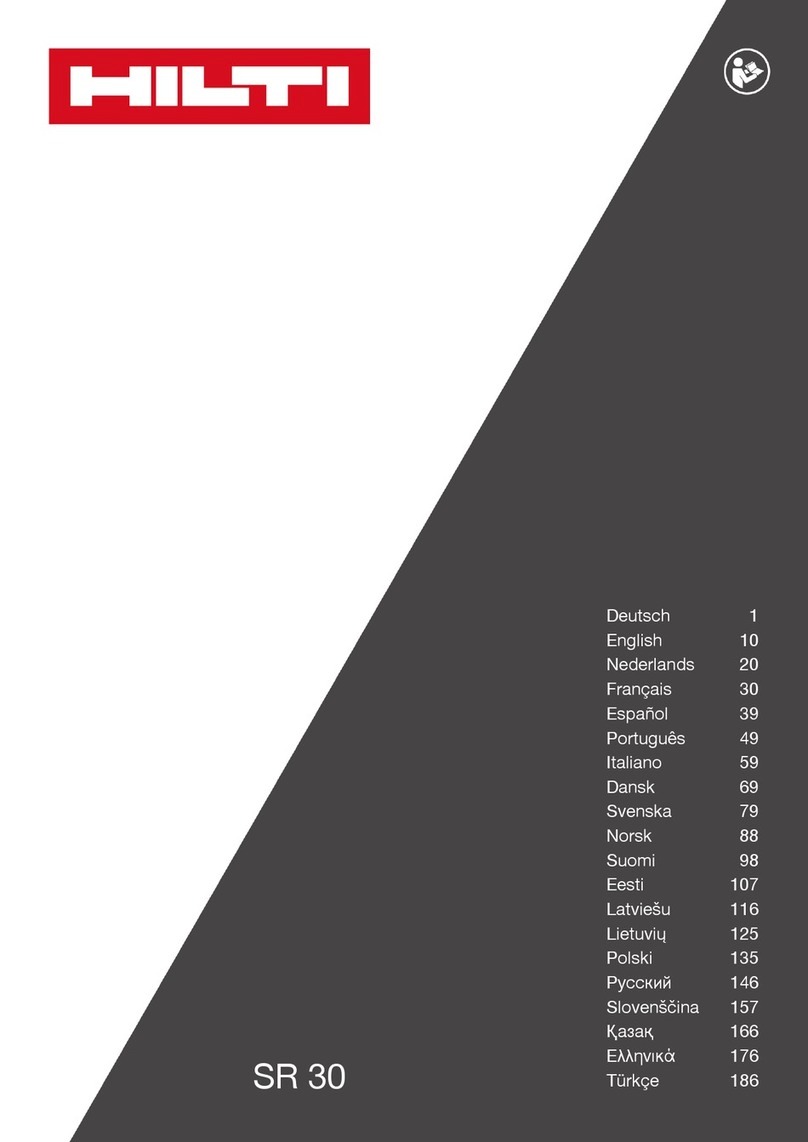
Hilti
Hilti SR 30 User manual
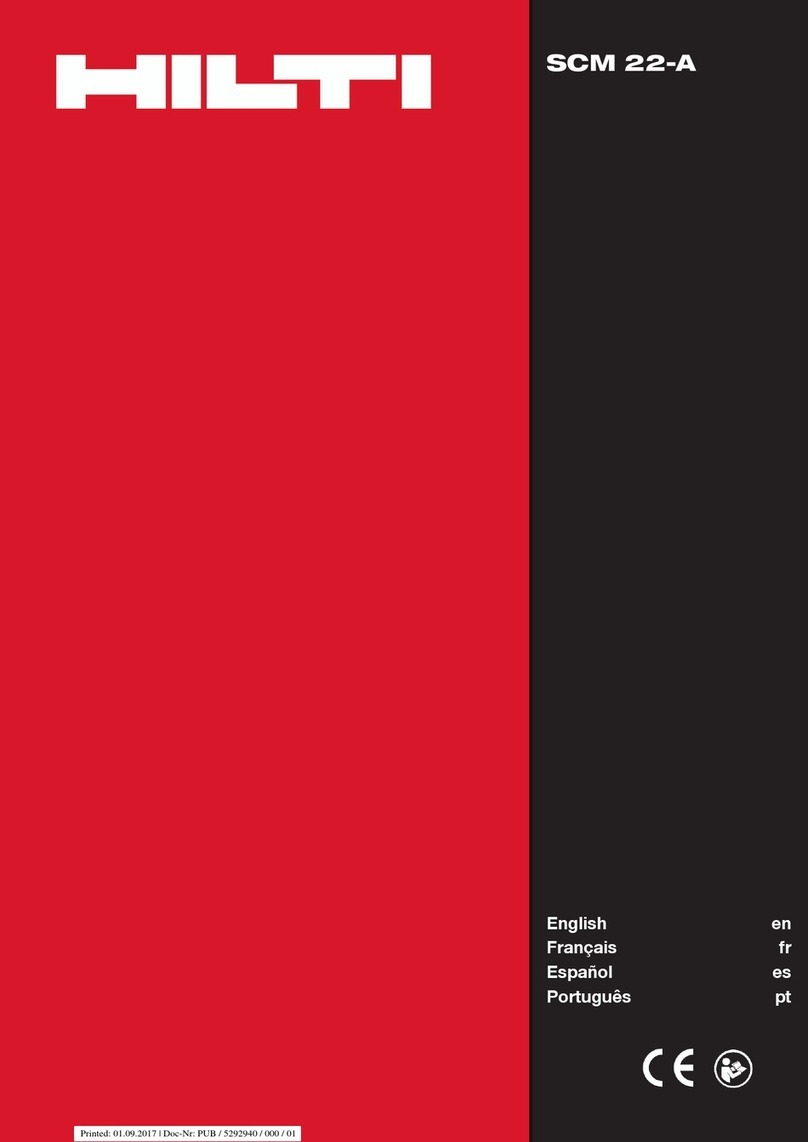
Hilti
Hilti SCM 22-A User manual

Hilti
Hilti SCO 6-A22 User manual

Hilti
Hilti SB 4-A22 User manual
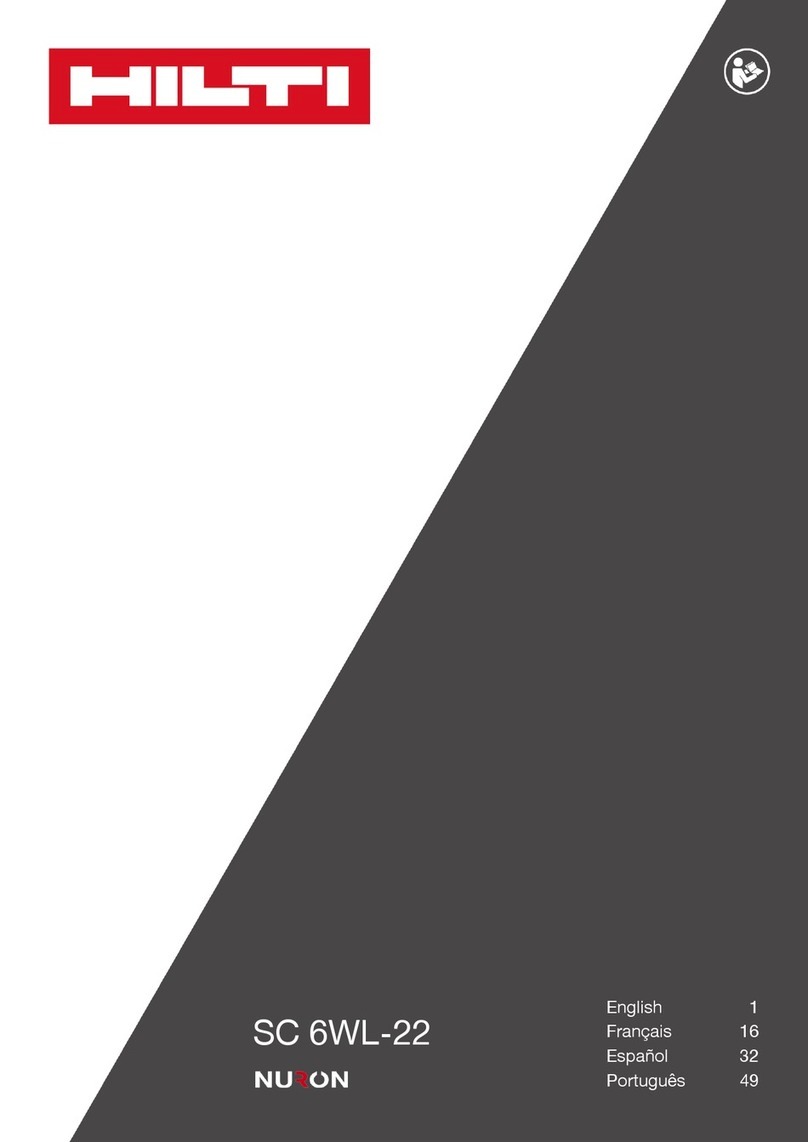
Hilti
Hilti Nuron SC 6WL-22 User manual

Hilti
Hilti DSW 1510-CA User manual

Hilti
Hilti SB 4-A22 User manual
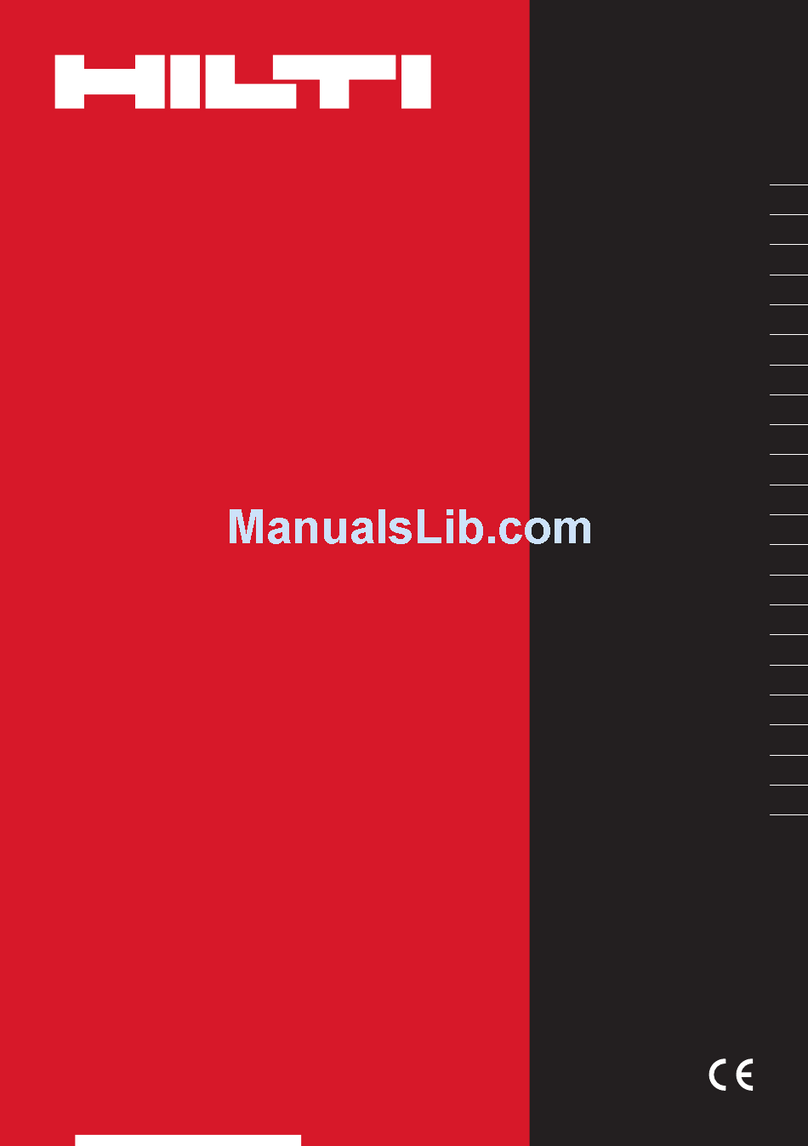
Hilti
Hilti SCW 70 User manual

Hilti
Hilti DSH 900 User manual

Hilti
Hilti NURON SB 4-22 User manual
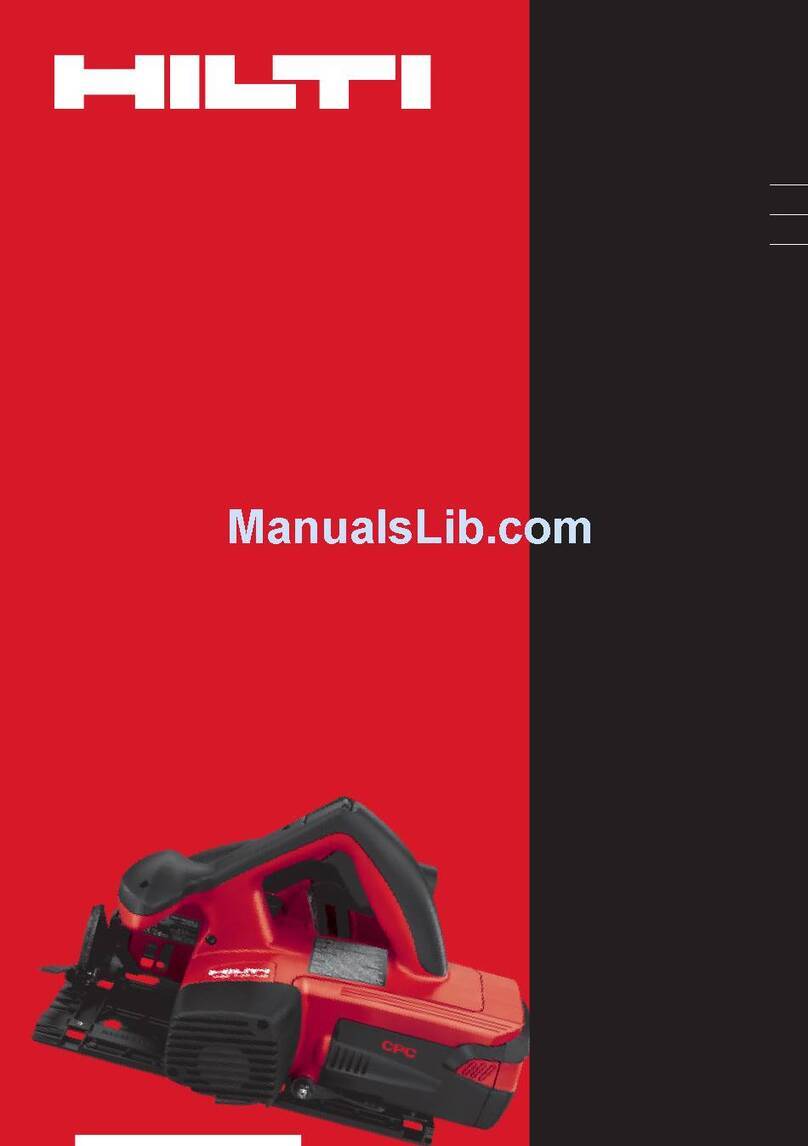
Hilti
Hilti WSC 7.25-A36 User manual
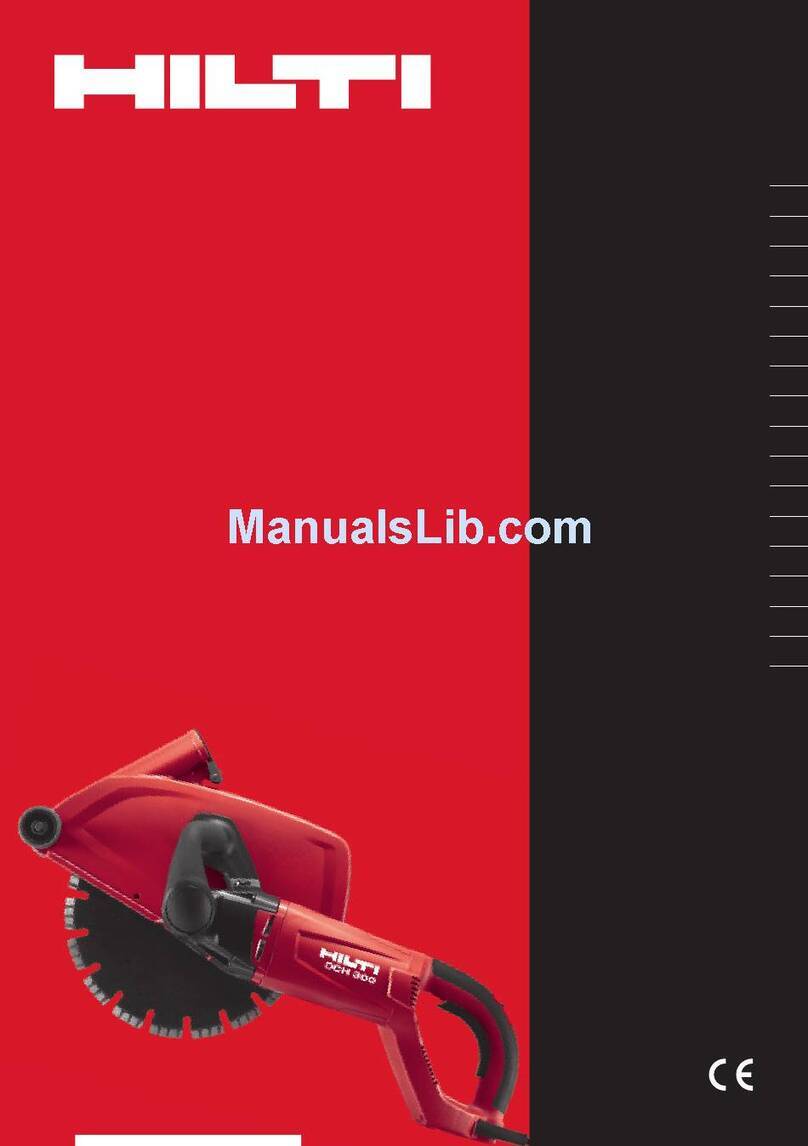
Hilti
Hilti DCH 300 User manual


